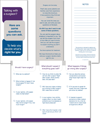Engaging Patients, Health Care Professionals, and Community Members to Improve Preoperative Decision Making for Older Adults Facing High-Risk Surgery
- PMID: 27368074
- PMCID: PMC5071104
- DOI: 10.1001/jamasurg.2016.1308
Engaging Patients, Health Care Professionals, and Community Members to Improve Preoperative Decision Making for Older Adults Facing High-Risk Surgery
Abstract
Importance: Older patients are at greater risk for postoperative complications, yet they are less likely than younger patients to ask questions about surgery.
Objective: To design an intervention to improve preoperative decision making and manage postoperative expectations.
Design, setting, and participants: A Patient and Family Advisory Council (PFAC) was created to help identify preoperative decisional needs. The PFAC included 4 men and women who had previous experience with high-risk surgery as older patients or their family members; the PFAC met monthly at a local library from May 2014 to April 2015 to examine findings from a prior qualitative study and to integrate themes with PFAC members' experiences. Patient observations included 91 recorded conversations between patients and surgeons and 61 patient interviews before and after surgery. The PFAC members and other stakeholders evaluated 118 publicly available questions and selected 12 corresponding to identified needs to generate a question prompt list (QPL). Three focus groups, including 31 community members from diverse backgrounds, were conducted at community centers in Madison and Milwaukee, Wisconsin, to refine the QPL. A clinical pilot with 42 patients considering surgery was conducted in one outpatient surgical clinic in Madison.
Main outcomes and measures: Generation of a QPL to address patients' preoperative informational and decisional needs.
Results: Through exploration of qualitative data, the PFAC noted 3 critical problems. Patients and family members believed surgery had to be done, were surprised that postoperative recovery was difficult, and lacked knowledge about the perioperative use of advance directives. The PFAC identified a need for more information and decisional support during preoperative conversations that included clarification of treatment options, setting postoperative expectations, and advance care planning. The following 3 question prompt categories arose: "Should I have surgery?" "What should I expect if everything goes well?" and "What happens if things go wrong?" The final list included 11 questions within these domains, was understandable in English and Spanish, and was acceptable to patients in the clinic.
Conclusions and relevance: Through direct engagement of stakeholders, a QPL was created to address core decisional and informational needs of surgical patients. Future testing will evaluate whether this list can be used to improve patient engagement and reduce postoperative regret and conflict about postoperative treatments.
Conflict of interest statement
The authors have no conflicts of interest—including relevant financial interests, activities, relationships, and affiliations—to report.
Figures
Comment in
-
Patient-Centered Outcomes Research-Opportunities for Novel, Innovative, and Transformative Partnerships With Patients and Their Families.JAMA Surg. 2016 Oct 1;151(10):945-946. doi: 10.1001/jamasurg.2016.1321. JAMA Surg. 2016. PMID: 27367617 No abstract available.
References
-
- Scarborough JE, Pappas TN, Bennett KM, Lagoo-Deenadayalan S. Failure-to-pursue rescue: explaining excess mortality in elderly emergency general surgical patients with preexisting"do-not-resuscitate" orders. Ann Surg. 2012;256(3):453–461. - PubMed
Publication types
MeSH terms
Grants and funding
LinkOut - more resources
Full Text Sources
Other Literature Sources
Medical
Miscellaneous



